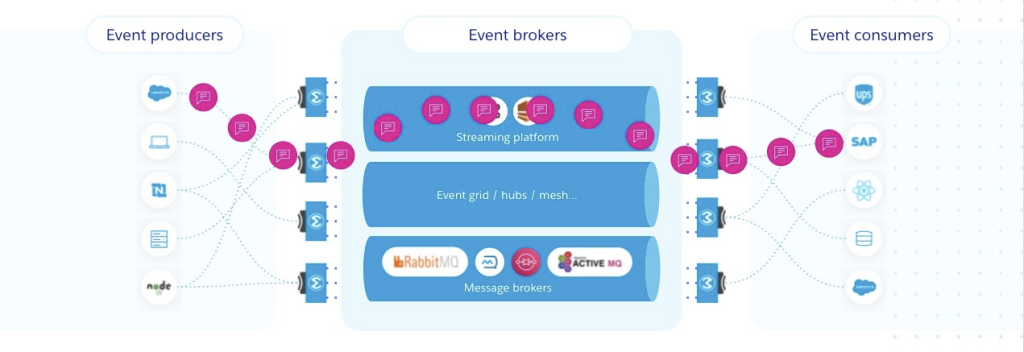Have you ever experienced anxiety when you see the dreaded “wheel of death” that appears when a browser takes too long to load? As consumers, we expect businesses to respond to our requests immediately irrespective of the channel of communication. According to a customer support survey from HubSpot, 82% of consumers look for an immediate response (<10 minutes) from brands.
Real-time experiences are critical for positive and efficient customer experiences and enterprise event-driven API journeys are key to making those experiences happen. In this article, I’ll share the many benefits of an enterprise event-driven API strategy and how, without one, you could lose revenue, see a drop in users, and have increased overhead costs.
Is your digital backbone ready for the future?
Amid such rapidly rising customer expectations, businesses need to respond to customers faster than ever. To gain perspective, let’s examine the value of time to an organization.

Image caption: What is the added value of real-time experiences for your company? To be more specific, what is the value of time. This could mean losses in revenue, a drop in user conversion rate, or additional delays in logistics costing you millions of dollars
To be more specific, what is the value of 10 milliseconds? Some companies found that it could be somewhere north of $80M in revenue if you are in capital markets (Source: Tabb Group’s “The Value of a Millisecond: Finding the Optimal Speed of Trading Infrastructure” article.) In the mobile apps space, this could mean a loss of users. These were measured for individual companies in specific domains, but what could a lack of real-time experiences be costing your business?
React in real-time with event-driven architectures
Neither the value of time mentioned above nor the need for real-time experiences is a novel idea. The reason enterprises find it challenging to accelerate to real-time is because the architectures that power such experiences fail to scale in today’s world of microservices and containerized deployments. Before enterprises embark on their “real-time” journey, it is imperative to understand what it takes to power a real-time experience. Here are three things enterprises need to do for successful real-time experiences:
- Identify and capture events in a secure, reliable, and agile fashion
- Establish infrastructure to handle these events and distribute them around the globe, across both cloud and on-premise environments
- Consume these events and power experiences to quickly react to changing conditions within the organization, market, or industry

Image caption: Event-driven systems require producers, consumers, and brokers. The number of producers and consumers both have increased exponentially and brokers evolved into streaming platforms. All these systems come with massive costs and limited ability to discover, design, and govern events
What’s in it for you?
Events are ubiquitous and perpetual, agnostic of industry. They can range from fraud detection, workflow notifications, news feeds, stock ticks, and more. With the shift to APIs backed by a microservice architecture, the number of such published events has grown exponentially. Leveraging these events in an architecture enables enterprises to:
- Make decisions or respond in real-time: Executing services in parallel decreases overall response times
- Reduce operational costs: Without constant polling for data, enterprises avoid consuming resources inefficiently, therefore, saving network and infrastructure costs
- Improve flexibility and scalability: Loosely coupled architectures build on asynchronous interactions do not have dependencies on downstream services
- Avoid cascading failures: Leveraging fault-tolerant services reduces the risk of information loss during failures
While microservices are often better at scaling and recovery when asynchronous interactions are involved, they are complex to manage compared to synchronous interactions (RESTful). To leverage the stability offered by REST APIs and flexibility offered by event-driven APIs, enterprises should start adding solutions built on event-driven APIs while continuing to invest in RESTful, synchronous interactions.
Scaling the adoption of event-driven architectures with MuleSoft
Event-driven architectures have existed for a long time, but they have never benefited from the API-led approach that fueled the adoption of REST APIs. To become more responsive, the enterprise architecture needs to support event-driven interactions with APIs that have structured definitions, be readable, and become reusable.
MuleSoft’s customers would be able to build event-driven API specs using AsyncAPI specification, a new machine and human-readable standard for asynchronous communication similar to OAS. MuleSoft customers would be able to scale the adoption of event-driven architectures in the Anypoint Platform with the ability to:
- Unlock events in their enterprise: Build real-time and responsive experiences by designing, cataloging, and reusing Event-driven APIs to invoke services asynchronously
- Scale efficiently, with confidence: Unlock agility with loosely-coupled services built on event-driven APIs that scale independently
You can get started with event-driven APIs on Anypoint Platform by signing up for a free trial, downloading Anypoint Studio, or learning more about the release in our MuleSoft documentation.









